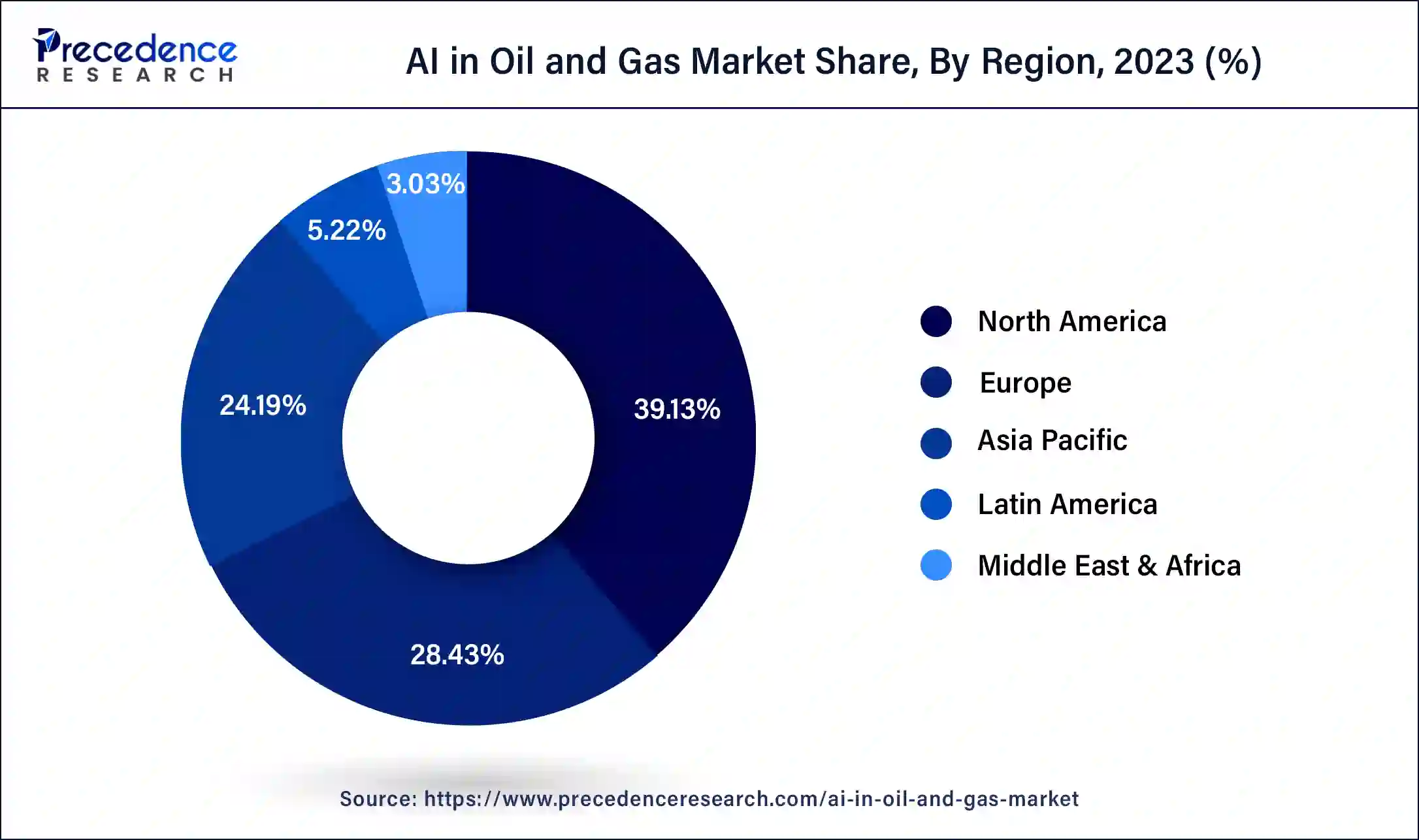What is the Artificial Intelligence (AI) in Oil and Gas Market Size?
The global artificial intelligence (AI) in oil and gas market size was valued at USD 7.64 billion in 2025, calculated at USD 8.73 billion in 2026, and is expected to reach around USD 25.24 billion by 2034. The market is expanding at a solid CAGR of 14.2% over the forecast period 2025 to 2034.

Artificial Intelligence (AI) in Oil and Gas Market Key Takeaways
- North America dominated AI in oil and gas market with 39.13% of the total revenue share in 2024.
- By Function, the predictive maintenance segment has accounted revenue share of around 31% in 2024.
- By Application, the upstream segment has captured the largest market share 52.3% in 2024.
- By Component, the software segment is expected to hold the largest market share over the forecast period.
Market Size and Forecast
- Market Size in 2025: USD 7.64 Billion
- Market Size in 2026: USD 8.73 Billion
- Forecasted Market Size by 2034: USD 25.24 Billion
- CAGR (2025-2034): 14.20%
- Largest Market in 2024: North America
Market Overview
Artificial Intelligence (AI) in the oil and gas industry refers to the application of advanced computer algorithms and machine learning techniques to enhance and automate various processes and operations within the exploration, production, distribution, and management of oil and natural gas resources. AI technologies in this sector leverage large volumes of data, including geological, geophysical, and operational data, to provide insights, optimize decision-making, and improve overall efficiency and safety.
The future demand for artificial intelligence in the oil and gas industry is expected to expand companies are using AI for predictive maintenance, reservoir management, and drilling optimization. Edge computing and machine learning are emerging technologies that deliver operational efficiency, safety, and real-time decision making in complex environments, which accelerates the digital transformation process and reduces carbon footprints.
Artificial Intelligence (AI) in Oil and Gas Market Growth Factors
By analyzing and interpreting this data, AI systems can help oil and gas companies make informed decisions, predict equipment failures, optimize production processes, reduce operational costs, and mitigate environmental risks, ultimately leading to increased profitability and sustainability in the industry. The AI in oil & gas industry is being driven by several factors such as rising collaborations, increasing product launches, increasing operational efficiency, rising government initiatives, and growing technological advancements.
Market Scope
| Report Coverage | Details |
| Market Size in 2025 | USD 7.64 Billion |
| Market Size in 2026 | USD 8.73 Billion |
| Market Size by 2034 | USD 25.24 Billion |
| Growth Rate from 2025 to 2034 | CAGR of 14.2% |
| Largest Market | North America |
| Base Year | 2025 |
| Forecast Period | 2025 to 2034 |
| Segments Covered | Component, Function, Application and Region |
| Regions Covered | North America, Europe, Asia-Pacific, Latin America, and Middle East & Africa |
Market Dynamics
Drivers
Reduced production and maintenance cost
Oil & gas remain in a single spot after extraction. Pipelines are used to distribute them afterward. Variable temperature and weather cause oil and gas components to corrode and deteriorate, which can decrease the condition of the pipeline and cause the threading to fade. This is one of the main issues facing the sector. To prevent catastrophic events, the oil & gas business must address these challenges right now. The industry may benefit from the incorporation of AI technologies by avoiding such occurrences.
By evaluating the data captured for many criteria, technologies like AI and IoT can find early indications of any such damage. To detect the likelihood of corrosion and inform managers to deal with the problems before they occur, several algorithms are delivered into AI solutions that employ knowledge graphs and predictive intelligence. Companies may schedule their maintenance procedures to prevent equipment failure-related downtime. Thus, these benefits of implementing AI in the oil & gas industry are expected to propel the market growth over the forecast period.
Restraint
High initial investment and integration complexity
Implementing AI technologies, including infrastructure, software, and skilled personnel, can involve substantial upfront costs. Smaller companies may find it challenging to allocate the necessary resources. Moreover, integrating AI systems with existing legacy systems and workflows can be complex and time-consuming. Compatibility issues may arise, requiring customized solutions. Therefore, the high initial investment and integration complexity are expected to be a major challenging factor to the market growth over the forecast period.
Opportunity
Requirement of precised defect detection
The machinery always runs under extreme pressures and temperatures. Natural processes like material deterioration and corrosion can cause major mishaps and damage. It is prone to errors to monitoring the equipment manually. The ML models monitor each component, recognize possible dangers, and supply the solutions in conjunction with the IoT, a smart system that employs small sensors to track anything from individual pieces of equipment to whole manufacturing lines. Thus, this is expected to offer a lucrative opportunity for the market growth.
Segments Insights
Component Insights
Based on the component, the global artificial intelligence in oil and gas market is segmented into software, hardware and services. The software segment is expected to hold the largest market share over the forecast period. These platforms form the foundation of AI applications in the industry. They allow companies to process, analyze, and gain insights from large datasets. Software such as TensorFlow, PyTorch, and scikit-learn is used to develop and deploy machine learning models for tasks like reservoir prediction, equipment maintenance, and demand forecasting. Predictive maintenance software leverages AI to monitor the condition of equipment and predict when maintenance is required. Popular solutions include IBM Maximo predictive maintenance and GE Digital Predix APM. Thus, this is expected to drive the segment expansion during the forecast period.
Function Insights:
Based on the function, the global artificial intelligence (AI) in oil and gas market is segmented into predictive maintenance, machinery inspection, material movement, production planning, field services, quality control and reclamation. The predictive maintenance segment is expected to dominate the market during the forecast period. Predictive maintenance is a critical application of AI in the oil & gas industry. It involves the use of AI algorithms and data analysis to predict when equipment and machinery in the oil & gas sector will require maintenance or replacement.
There are various benefits of predictive maintenance in the oil & gas industry such as reduced downtime, cost savings, extended equipment lifespan, and others. Unplanned downtime in oil & gas operations can be extremely costly. Predictive maintenance helps prevent unexpected equipment failures, minimizing production interruptions and losses. Moreover, by identifying maintenance needs in advance, companies can plan and schedule maintenance activities more efficiently. This reduces the overall maintenance cost and avoids unnecessary replacements or repairs. Thus, this is expected to be a reason for segment growth during the forecast period.
Application Insights
The global artificial intelligence In oil and gas market is segmented into upstream, midstream and downstream. The upstream segment is expected to capture the largest market share over the forecast period. AI is making a significant impact on the upstream sector of the oil & gas industry, which involves activities related to exploration, drilling, and production.
AI technologies are being leveraged in several ways to optimize operations and improve efficiency in upstream activities. AI algorithms analyze seismic data to identify potential hydrocarbon reserves more accurately. Machine learning models can identify subsurface structures and predict the presence of oil and gas with greater precision. AI systems process real-time data from drilling operations to optimize drilling parameters, detect anomalies, and make immediate adjustments to improve drilling efficiency and minimize downtime.
For instance, companies like BP and Royal Dutch Shell are under increased pressure to reduce their carbon footprint to comply with the Paris Agreement and their commitment to achieve net-zero carbon emissions by 2050. To reduce its carbon impact, Shell is using AI technology to do proactive maintenance on specific equipment or entire systems, this enables businesses to anticipate and address any equipment failures before they arise. Thus, this is expected to propel the segment expansion during the forecast period.
Regional Insights
U.S. Artificial Intelligence (AI) in Oil and Gas Market Size and Growth 2025 to 2034
The U.S. artificial intelligence (AI) in oil and gas market size was estimated at USD 2.12 billion in 2025 and is predicted to be worth around USD 7.34 billion by 2034, at a CAGR of 14.8% from 2025 to 2034.

North America is expected to dominate the market over the forecast period. The market growth in the region is attributed to the presence of major players such as Google LLC, IBM Corporation, and C3.ai, Inc. These players continuously launch the innovative AI solution in the regional market. For instance, in May 2024, IBM released IBM Watsonx, as a latest AI and data platform that in planned to be available for business to hasten the impact of the most cutting-edge artificial intelligence with accountable data. Moreover, the oil & gas companies in North America utilize AI to optimize exploration efforts. Machine learning algorithms process vast amounts of geological and geophysical data to identify potential reserves more accurately.
The United States AI in oil and gas market is the most advanced and dynamic market in the world, driven by a proactive digitization agenda and early tech adoption. Most of the major oil companies such as Chevron ExxonMobil, Halliburton, use predictive maintenance AI programs, and in addition are using real-time drilling analytics and reservoir modelling. There is very strong cooperation in innovation between oil companies and AI startups in the US, and, with charter tech ecosystems such as Silicon Valley and Houston's Energy Corridor, the US is advancing upstream innovation and digital oilfield solutions quicker than other parts of the world. Government incentives and funding is driving improvements to automation and sustainability across the value chain. China: China's AI integration in oil and gas is rapidly expanding and is supported by national strategies and strong investment in artificial intelligence technology. State-owned enterprises like Sinopec and CNPC are utilizing AI for with their seismic data, drilling models, and supply chain automation. As the world's largest refining capacity and increasing energy demands in China, strategically using AI will allow both state-owned enterprises and private companies to increase productivity while maintaining a reduced dependence on foreign technologies. China's national AI strategies will assimilate these digital energy initiatives at a national scale making it one of the fastest growing markets in the sector. India: The market for AI in oil and gas in India is maturing, with companies like ONGC, Reliance Industries, and Indian Oil using AI to drive exploration, improve fuel logistics, and enhance safety. There are government-backed digitization programs and partnerships with AI solution providers that are spurring new developments. The pressure to better leverage and optimize oil imports, reduce loss, and improve operating efficiency, makes AI strategically useful as part of India's energy transition. As digital infrastructure is in maturing digital infrastructure, India stands to become a major player in AI-led energy management.
For instance, BP is utilizing artificial intelligence to optimize its operations and improve reservoir modeling. The company has developed an artificial intelligence algorithm which can analyze geologic data to help identify the best locations for drilling. Earlier, BP has also used artificial intelligence to perform predictive maintenance on its equipment while improving safety.

Asia Pacific is expected to grow at the highest CAGR during the forecast period.The market growth in the region is owing to the increasing oil & gas exploration and production activities. For instance, according to the International Energy Agency, By 2025, Asia Pacific will produce 676 bcm more gas than it did in 2019. Due to ongoing policy support for domestic production, China will add 54 bcm/y of additional output by 2025 while traditional gas-producing nations (such as Indonesia, Malaysia, Myanmar, and Thailand) see steady reductions.
The second-largest producer of gas in the area, Australia, stabilizes production at just about 150 bcm/y as a result of new developments substantially offsetting reductions from mature fields. India increased output by 12 bcm/y in 2019–25, with a small number of ongoing deepwater development projects accounting for the majority of the net increase. Furthermore, the growing digitalization initiatives are also propelling the market growth over the forecast period. As part of digitalization efforts, companies in the Asia Pacific oil & gas sector are implementing AI solutions to transform data into actionable insights, streamline processes, and enhance operational efficiency. Thus, this is expected to propel the market growth in the Asia Pacific region.
Artificial Intelligence (AI) in Oil and Gas Market Companies
- Microsoft Corporation
- FuGenX Technologies Pvt. Ltd
- IBM Corporation
- C3.AI
- Google LLC
- NVIDIA Corp.
- Royal Dutch Shell PLC
- PJSC Gazprom Neft
- Huawei Technologies Co. Ltd
- Intel Corporation
- Neudax
- Infosys Limited
Recent Developments
- On January 22, 2025, SandboxAQ signed an agreement with Saudi Aramco to co-develop a multi-GPU differentiable computational fluid dynamics (CFD) solver tailored for oil and gas facilities marking a leap forward in process optimization through AI-enhanced simulation.
(Sources- https://worldoil.com) - In March 2025, the DISTINGUISH workflow (March 11) was introduced, using generative adversarial networks to enable real-time geo-steering, dynamically updating subsurface models and improving directional drilling decisions.
(Sources- https://arxiv.org) - In March 2025, VERSES AI Inc., a cognitive computing company specializing in next generation intelligent agent systems, announced that AI Driller, a leading AI solutions company focused on providing a comprehensive operational platform for safer and smarter drilling and completions solutions for the oil and gas industry, has joined the Genius commercial program. Predictive capabilities of Genius™ enable safer and smarter drilling solutions for the oil and gas industry. (Source: https://www.globenewswire.com)
- In February 2025, Windward, a self-described maritime AI company, launched its Critical Maritime Infrastructure Protection tool, an AI-powered technology designed to protect the “world's essential maritime infrastructure,” including subsea cables and pipelines. This technology addresses three primary threats to maritime infrastructure: deep-sea research operations, shallow-water sabotage, and attacks on offshore oil rigs and platforms. (source: https://www.offshore-mag.com)
- In October 2024, Baker Hughes and Repsol announced an agreement to collaborate on the development and deployment of artificial intelligence (AI) capabilities for automated field production. This platform is designed to help oil and gas operators manage production and reduce carbon emissions. Amerino Gatti, executive vice president of oilfield services and equipment at Baker Hughes, stated, “Artificial intelligence is revolutionizing energy production, and Leucipa enables companies to operate more efficiently to recover more from their assets.” (Source: https://jpt.spe.org)
- In November 2024, APA Corporation APA, a Houston, TX-based oil and gas exploration and production company, has expanded its partnership with Palantir Technologies Inc. (PLTR) to integrate AI-driven solutions across its extensive operations. This move shows a strategic effort to unlock new levels of performance, reduce costs, and drive sustainability in a market that is increasingly reliant on technological advancements. (Source: https://www.nasdaq.com)
- In June 2023, a prominent software development firm, OgesTM Solutions, announced the debut of OgesOneTM. This new software platform is powered by SAS Analyitcs for IoT which is based on the industry's leading cloud-native AI platform, SAS Viya.
- In September 2023, INEOS Energy and SLB announced that they have entered into a subsurface technological cooperation. INEOS and SLB will engage with each other in order to improve operational performance for future expansion. Under the agreement, INEOS Energy will include the SLB Delfi digital platform into all aspects of its subsurface.
Segments Covered in the Report
By Component
- Software
- Hardware
- Services
By Function
- Predictive Maintenance
- Machinery Inspection
- Material Movement
- Production Planning
- Field Services
- Quality Control
- Reclamation
By Application
- Upstream
- Midstream
- Downstream
By Region
- North America
- Europe
- Asia-Pacific
- Latin America
- Middle East and Africa
For inquiries regarding discounts, bulk purchases, or customization requests, please contact us at sales@precedenceresearch.com
Frequently Asked Questions
Ask For Sample
No cookie-cutter, only authentic analysis – take the 1st step to become a Precedence Research client
 sales@precedenceresearch.com
sales@precedenceresearch.com
 +1 804-441-9344
+1 804-441-9344